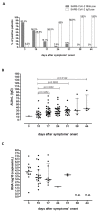SARS-CoV-2 Virologic and Immunologic Correlates in Patients with Olfactory and Taste Disorders
- PMID: 32679910
- PMCID: PMC7409064
- DOI: 10.3390/microorganisms8071052
SARS-CoV-2 Virologic and Immunologic Correlates in Patients with Olfactory and Taste Disorders
Abstract
The main object of the study was to investigate the SARS-CoV-2 molecular and serological pattern in patients with mild symptoms including anosmia and ageusia. A cohort of 69 patients with olfactory and taste disorders (OTDs) were enrolled and prospectively monitored. Serological and molecular assays for the characterization of SARS-CoV-2 IgG and SARS-CoV-2 RNA, respectively, were performed at the time of enrolment and after 7 and 14 days. Patients were stratified according to the symptoms' onset. A total of 52 patients (75.4%) were diagnosed as COVID-19 positive being SARS-CoV-2 RNA and/or SARS-CoV-2 IgG positive. The remaining 17 (24.6%) were negative for COVID-19 and excluded from the analysis. We reported that only 34 out of 52 patients (65.4%) were positive for SARS-CoV-2 RNA. Moreover, the median time from onset of symptoms and enrolment was significantly higher in those patients with negative SARS-CoV-2 RNA in nasal swabs, suggesting that symptoms might last longer than SARS-CoV-2 replication. The great majority of patients (80%) developed SARS-CoV-2 IgG at three weeks after symptoms' onset while the detectability of SARS-CoV-2 RNA dramatically decreased over time, suggesting the crucial role of combination of molecular and serological assays for the diagnosis of COVID-19 in those patients reporting mild symptoms.
Keywords: SARS-CoV-2; ageusia; anosmia; serology.
Conflict of interest statement
The authors declare no conflicts of interest.
Figures


Similar articles
-
High Frequencies of Functional Virus-Specific CD4+ T Cells in SARS-CoV-2 Subjects With Olfactory and Taste Disorders.Front Immunol. 2021 Nov 10;12:748881. doi: 10.3389/fimmu.2021.748881. eCollection 2021. Front Immunol. 2021. PMID: 34858405 Free PMC article.
-
Loss of smell or taste as the only symptom of COVID-19.Tidsskr Nor Laegeforen. 2020 Apr 3;140(7). doi: 10.4045/tidsskr.20.0287. Print 2020 May 5. Tidsskr Nor Laegeforen. 2020. PMID: 32378854 English, Norwegian.
-
Signs and symptoms to determine if a patient presenting in primary care or hospital outpatient settings has COVID-19.Cochrane Database Syst Rev. 2021 Feb 23;2(2):CD013665. doi: 10.1002/14651858.CD013665.pub2. Cochrane Database Syst Rev. 2021. Update in: Cochrane Database Syst Rev. 2022 May 20;5:CD013665. doi: 10.1002/14651858.CD013665.pub3. PMID: 33620086 Free PMC article. Updated.
-
Prevalence of Chemosensitive Neurological Disorders of Smell and Taste and Association with Blood Groups in SARS-CoV-2 Patients: Cross-Sectional Study.Viruses. 2023 May 30;15(6):1277. doi: 10.3390/v15061277. Viruses. 2023. PMID: 37376577 Free PMC article.
-
Onset and duration of symptoms of loss of smell/taste in patients with COVID-19: A systematic review.Am J Otolaryngol. 2021 Mar-Apr;42(2):102889. doi: 10.1016/j.amjoto.2020.102889. Epub 2021 Jan 6. Am J Otolaryngol. 2021. PMID: 33445036 Free PMC article.
Cited by
-
Clinical, virological and immunological evolution of the olfactory and gustatory dysfunction in COVID-19.Am J Otolaryngol. 2022 Jan-Feb;43(1):103170. doi: 10.1016/j.amjoto.2021.103170. Epub 2021 Aug 8. Am J Otolaryngol. 2022. PMID: 34391165 Free PMC article.
-
Covid-19 and oral diseases: Crosstalk, synergy or association?Rev Med Virol. 2021 Nov;31(6):e2226. doi: 10.1002/rmv.2226. Epub 2021 Mar 1. Rev Med Virol. 2021. PMID: 33646645 Free PMC article. Review.
-
Electrophysiological evidence of subclinical trigeminal dysfunction in patients with COVID-19 and smell impairment: A pilot study.Front Neurol. 2022 Oct 14;13:981888. doi: 10.3389/fneur.2022.981888. eCollection 2022. Front Neurol. 2022. PMID: 36313508 Free PMC article.
-
Pathogenic Mechanism and Multi-omics Analysis of Oral Manifestations in COVID-19.Front Immunol. 2022 Jul 4;13:879792. doi: 10.3389/fimmu.2022.879792. eCollection 2022. Front Immunol. 2022. PMID: 35860279 Free PMC article. Review.
References
-
- Zhong N.S., Zheng B.J., Li Poe Y.M., Xie Z.H., Chan K.H., Li P.H., Tan S.Y., Chang Q., Xie J.P., Liu X.Q., et al. Epidemiology and cause of severe acute respiratory syndrome (SARS) in Guangdong, People’s Republic of China, in February, 2003. Lancet. 2020;362:1353–1358. doi: 10.1016/S0140-6736(03)14630-2. - DOI - PMC - PubMed
Grants and funding
LinkOut - more resources
Full Text Sources
Miscellaneous

